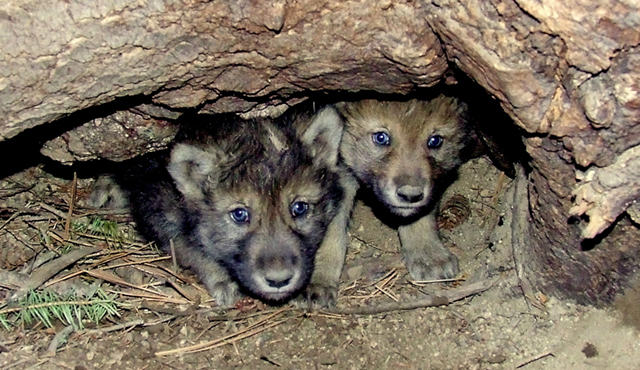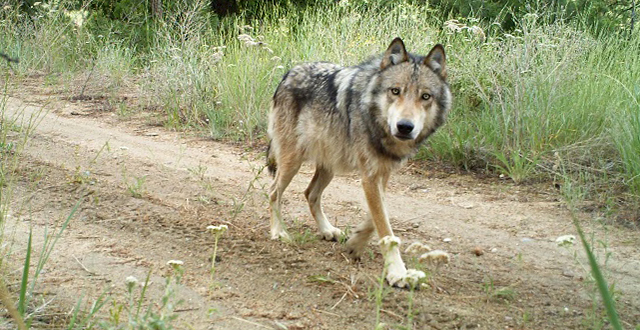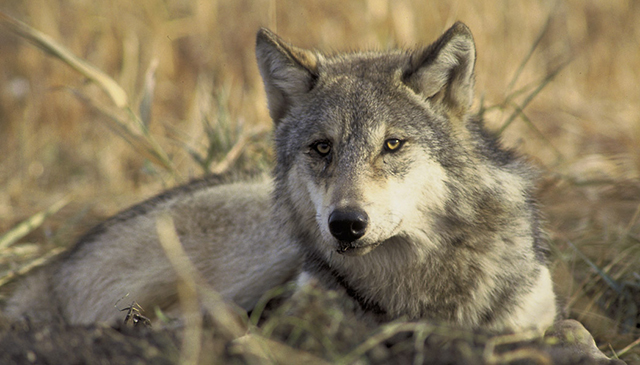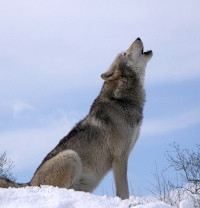Wolves? Where?
The gray wolf (Canis lupus) once roamed abundantly throughout Wisconsin but can now be found only in the northern half of the state where well established populations already exist. They need extensive areas of land where they have access to food, shelter and denning sites. Gray wolves will roam over their expansive home range and will often cover up to 30 miles a night in their territory.

Gray wolf pups emerging from their den. Photo: , U.S Fish and Wildlife Service
Their breeding season is January through March and they give birth to a litter of 5-7 pups once a year. The pups are born blind and with floppy ears in an underground den. They are weaned at 6-8 weeks and disperse from the den at 10 months of age when they are old enough to hunt on their own. A gray wolf will not become sexually mature until 2-3 years of age. An adult gray wolf typically weighs between 50 and 120 pounds and measures 26 to 34 inches at the shoulder.
Wolves have no natural predators other than humans and are generally shy and wary of people. With the arrival of European settlers and the practice of raising livestock wolves began to take advantage of the easy food source while their natural prey of bison, elk, deer and moose were being depleted by hunters. While they were once the most widely distributed mammal in the United States, this conflict led to a centuries-long extermination which nearly wiped them out in the 1930’s.
Though conservation efforts have had some success, currently the gray wolf occupies roughly 6% of its former range in the lower 48 states and its endangered status varies form state to state.

Gray wolf photo captured by a U.S. Fish and Wildlife Service remote camera.
Keystone Species
The predatory nature of the wolf has resulted in some strong associations throughout history. One the one hand you have the wolf as a symbol of a brave warrior, and on the other you have the quintessential big bad wolf character of Aesop’s Fables and Grimm’s Fairy Tales.
So while commonly seen as a threat, gray wolves are actually a keystone species in their ecosystem, meaning they have a disproportionate effect on the environment and ecosystem in proportion to their relative abundance.
Without wolves, we would naturally have many more deer, who would consume more plants and trees, thereby providing less habitat and food to other creatures, such as birds, beavers and decomposers. Keystone species have a dramatic effect on their environment and a recent reintroduction of wolves in Yellowstone National Park environment has helped the entire ecosystem, from beavers to eagles, to flourish.

Photo: U.S Fish and Wildlife Service
Wolf Facts
- The color of the gray wolf can range from the typical gray, to the more uncommon brown, black or even white.
- Wolves have howls which, much like a fingerprint, are unique to each wolf. Scientists that study wolves can actually identify an individual wolf just by listening to its howl.
- Wolves consume between 4-16 pounds of meat a day. Their diet is composed of mainly deer and moose, however up to a third of their diet is small mammals such as beavers, squirrels and rabbits.
- They have a unique social hierarchy of 5-9 wolves per pack. There is a dominant male and female in every pack, with the alpha male being the dominant wolf over the entire pack and all males being dominant to females. There are ranked male and female wolves in each pack and most members of the pack are offspring of the alpha male and female.
- They mate with their partners for life. The alpha male and female are the only ones to reproduce in a pack while the other members are responsible for helping to raise pups, defend their territory and hunt for the pack.
- The oldest living captive wolf was known to be 16 years old, however, wild wolves live more typically to be 7-8 years old.





